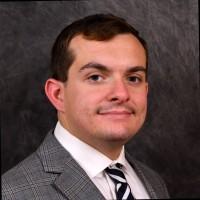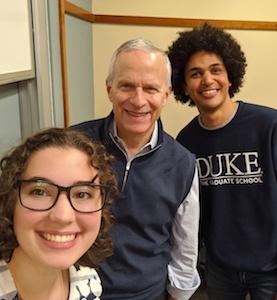
Four Sanford master’s students faced a question in class this spring: How could they help GoDurham improve the customer experience of Durham public transportation?
The MPP students in the course “Using Human-Centered Design to Improve the Citizen Experience” knew they needed to understand the customer experience for the answers. Over the semester, they learned and used human-centered design (HCD) skills to help answer this question.

“Many organizations do not interact directly with customers to learn what they want. HCD taught me the importance of speaking to customers face to face. When you do, something magical happens: They tell you what’s important to them!” said Forrest Robinette, MPP ’20.
To gain an understanding of the organization, their expectations and unmet needs, the students researched the GoDurham customer experience, uncovering bright spots and pain points of the customer journey. To conduct their research, the students divided into pairs, with one group interviewing employees from the general manager to bus operator and roles in between. Another team interviewed customers at Durham station, the central hub of GoDurham. Right away, the teams identified a pain point – the waiting experience for customers at the bus stop.

“Because I do not have a car in Durham and have always lived in major cities with public transportation, I found myself getting really immersed in this opportunity to better the experience of public transit-dependent customers. I was able to lean on my experiences with GoDurham buses to empathize with the problems faced by customers and frame my thinking for viable solutions to address some of their concerns,” said Afsana Oreen, MPP ’20.
The students worked with customers and employees to test different solutions to improve the customer experience. As they identified solutions for GoDurham, they recognized their ideas had to work for both the customers and the organization.

“GoDurham has to run a tight ship when it comes to resources because it is extremely important to the local community but has relatively little funding to meet that need. Thus, if we were going to ask (the organization) to take on an extra cost, we needed to have a good argument for them to do so,” said Matthew Boyle, MPP ‘21.
“One of our recommendations was to have GoDurham place physical bus schedules at high-volume stops so people would know when the bus was coming and would not feel like they were waiting forever. My ‘aha’ moment was figuring out how to articulate to our contact why it made sense to use the physical schedules and why an app would not provide the same value,” Boyle said.
In early May, the team shared their project results and recommendations with GoDurham in a HCD storybook that detailed all of the students’ work from the 14-week process.
“My team and I went through many iterations but by the final design solution, I believe we all felt that GoDurham would see an increase in customer service satisfaction and the customers’ experience in waiting for the bus would improve,” said Tikkara Cooper, MPP ’20.
Brian Fahey of GoTriangle served as the primary client contact for the students. “Through their research and interaction with customers and staff, the group identified key areas where customer service could be improved. The most fulfilling part of working with the students was getting a fresh perspective on GoDurham's strengths and weaknesses, and seeing innovative approaches to improving customer service,” Fahey said.
Course Background

Sanford faculty members Tom Allin and Blythe Meyer co-teach Sanford’s HCD course, which they call a “Citizen Experience Lab.” Before coming to Sanford, Allin served during the last two years of the Obama Administration as Chief Veterans Experience Officer at the Department of Veterans Affairs, setting up a Veterans Experience Office where his team used human-centered design to understand, design and measure the veteran experience. Meyer is a professional enterprise product designer with experience working with companies and organizations on every stage of design.
“Each year, I work with Durham City and Durham County to identify organizations that are open to working with students, want to improve their customer experience and are large enough to provide a challenge to the student team,” Allin said.
Human-Centered Design
Throughout the course, the students learn valuable HCD methodology and skills, in addition to engaging directly with the Durham community.
“One insight was when the professors explained why organizations so often fail to create systems that users enjoy. They usually consider their own needs first, and then that of the users. They end up creating a system that is convenient for them, but completely unsatisfying for the user. HCD puts the user experience first to avoid this,” Boyle said.
“My initial impression of the HCD course was that the class would require a great deal of effort but I'd gain a valuable skill for the workplace. After taking the course, I can definitely say my thought process was spot on!” Cooper said. “Now I see direct customer engagement, especially in terms of co-creating a solution, as an indispensable asset that I'll take with me throughout my career moving forward.”
The project was not without challenges, however, including a global pandemic midway through the semester.
“COVID-19 struck in the middle of our design phase. We were preparing to do a second round of customer interviews to get their feedback on our proposed design solution. Approaching customers in busy Durham Station and passing around clipboards to get signatures seems unthinkable now! Thankfully, we were at a stage in the project when we had conducted most of our primary research and we only needed to craft our implementation plan. Our instructors, our client, and our team showed creativity and resilience as we went remote,” Robinette said.
Student and Client Benefits
All of the students agreed that the client was a partner, and that they benefited from working in their own community.
“GoDurham was a great client. We had weekly check-in meetings. We used these meetings to give updates on our progress and seek GoDurham's advice on the feasibility and impact of our ideas. GoDurham often helped identify contacts inside the organization and customers whose perspectives would enrich our understanding of challenges salient for customers,” Oreen said.
“I learned about the passion and commitment that these public employees bring to their jobs in order to serve the people of Durham and the Triangle area. It reminded me that the city services so many people rely on are possible because of the hard work of many people behind the scenes. Working with GoDurham was inspiring; I think Duke should work to engage students with Durham organizations whenever possible,” Robinette said.
Fahey said working with Duke public policy students is equally beneficial.
“I would describe the student team as bright, talented young men and women who were truly interested and engaged throughout the project,” Fahey said. “The City of Durham and Duke have shared a strong relationship. By involving the public policy students in the community, Duke is broadening their role as a partner to improve the quality of life in Durham.”
Previous projects have focused on questions such as:
- How can Durham One Call improve the effectiveness and customer experience of its call center?
- How can Durham Public Schools improve the experience of first-year teachers?
- How might Durham Housing Authority communicate more effectively with our voucher holders, landlords and employees?
Allin often hears from students who take their HCD skills into their careers, such as Nicole Santeiro MPP ’20 who emailed him after graduation to share: “I am finishing up my first week of telework at Booz Allen Hamilton, and I wanted to check in with you about my experience so far. I must thank you again for leading such a great HCD class! Of all my classes at Sanford, yours was the most directly applicable to the work I will be doing in the ‘real world.’”
Meet the instructors:
